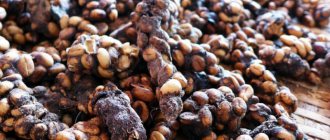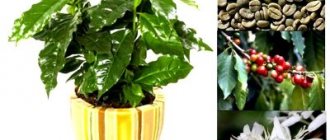General information about the coffee tree
Ethiopia is considered the birthplace of coffee. The plant is an evergreen. The height of trees in natural conditions reaches 10 m, and on plantations - 2.5 m. The branches are shortened to facilitate care and harvesting.
For cultivation at home, plants up to 1 m high are used. Coffee blooms from mid-spring to mid-autumn.
Beneficial features
Grains contain vitamins:
- IN 1;
- AT 2;
- RR.
The seeds contain macro- and microelements:
- iron;
- potassium;
- phosphorus;
- sodium;
- calcium;
- magnesium.
The seeds contain iron, potassium and phosphorus.
Caffeine benefits the body. It relieves headaches. The substance tones the brain, having a stimulating effect. Caffeine helps with nervous exhaustion and increased fatigue.
Biological characteristics of the plant
The evergreen coffee tree is part of the large Rubiaceae family. At home it often grows as a bush. This plant can be distinguished by its leathery oval leaves, which have a wavy surface and a rich green color. The tips of the elongated leaves are pointed. Blooms from mid-April to early October. On annual shoots, inflorescences are formed in the form of a false umbrella, consisting of 10 - 15 flowers. White fragrant flowers form a bunch.
The round fruits, initially olive-colored, turn red when ripe. The ripe berry is covered with a dense skin covering sweet pulp with a slight sourness and two to three seeds (their length does not exceed 13 cm). In nature, the perennial plant reaches 8 m or more. The height of home seedlings does not exceed 2 m. Usually, a coffee tree at home begins to bear fruit at the age of three. But if in the natural environment an adult bush brings about 3 kg per year, then at home it can produce approximately 600 g.
Tree structure
You can recognize the plant in the photo by its spreading branches. The berries located on them resemble bunches of grapes.
Fruit
The oblong or spherical fruit is called a cherry. After flowering ends, ripening lasts up to 8 months.
The cherry turns a bright red color. It contains from 1 to 3 seeds. The size of the berry does not exceed 1.5 cm.
Root system
The structure of the root system is taproot. The depth of germination depends on the type of coffee. Robusta roots have a depth of no more than 2 m. Arabica grows at 2.5-3 m.
Flowers
The white flowers have a scent reminiscent of jasmine. The presence of male and female characteristics allows self-pollination. Inflorescences are arranged in bunches.
The flowers of the coffee tree have a strong aroma.
Crown
The height of the crown depends on the type of coffee. In the Congolese variety, it does not exceed 2 m. In Arabica, the crown height reaches 6 m. The branches of the tree are inclined to the ground.
Leaves
The leaves have a glossy surface. Their lifespan ranges from 3 to 5 years. The oval leaves reach 20 cm in length and 5 cm in width. The venation is pinnately uneven, reticulate.
Coffee varieties for home growing
There are about 60 varieties of coffee, but three varieties are suitable for home breeding:
- Arabian is the most common variety for growing at home. After the small flowers fully open, rapid wilting begins. Berries appear on the shoots, slowly changing color from olive to burgundy.
- Liberian is a popular variety for growing indoors. Ripe fruits are orange in color and become scarlet over time. The leaves and flowers are large.
- Nana (dwarf) is a very decorative variety, characterized by abundant flowering and small (0.4 - 0.6 m) growth. Convenient for transportation.
When thinking about how to grow a beautiful and strong coffee tree, you carefully choose planting material. Creating comfortable conditions and following the rules of agricultural technology will be the key to the development of a healthy plant.
Popular varieties
Scientists count more than 100 types of coffee. Plantation owners often cultivate Arabian and Congolese varieties. Hybrids of these varieties are also grown.
Arabian
The Arabian variety has become widespread. It blooms 2 times a year. Under natural conditions, Arabica reaches 7-8 m in height.
For home breeding, a dwarf variety is used, the height of which does not exceed 0.8 m.
Congolese
Congolese coffee is called Robusta, which means “strong”, “strong”. The variety is resistant to diseases and pests. Robusta is easy to care for and has high yields. The Congolese variety has a higher caffeine content. But its taste is lower than that of other varieties. Robusta is added to coffee blends.
Congolese coffee is easy to care for.
Liberian
The variety was discovered in Liberia. The first plantation appeared in 1864. Coffee was first planted in the Philippines. He was then transported to Indonesia. Here, the Liberian variety replaced the Arabica, which was destroyed by bad weather conditions. The grains have a strong aroma, but have a weak taste. For this reason they are used in mixtures. The caffeine content of the Liberian variety is reduced.
general description
Coffee trees belong to the Rubiaceae family. Traditionally, they are divided into several types according to the type of grains obtained. For the consumer, the difference comes down to taste. Most coffee comes from a plant called Arabian coffee (or Arabica) , the second most popular species of Congo coffee (or Robusta). The taste of the latter has a fairly pronounced sourness.
Coffee tree in nature. Ethiopian Harar variety, Arabica
Typically, Arabica is a low-growing plant, and Robusta is a tall plant . But under different growing conditions, it is quite possible that the growth of Arabica will not be inferior to that of Robusta (for example, Arabica grown in the Hawaiian Islands).
Congolese coffee. Karamu variety, Robusta
The fruits of the coffee tree, or coffee beans, are structured exactly the same for all representatives of coffee trees and differ only in size and flavor. The core of coffee beans, actually the seed of the fruit, is the very substance from which the well-known drink is obtained. Depending on the type of coffee tree, from each of them you can get from 0.2 to 10 kg of coffee beans per season.
Opened coffee fruit with two beans inside
There are about a hundred species of the Rubiaceae family in the world, growing in different parts of the globe.
Some of them can be adapted for growing at home in our area. The main problem in growing is not providing the temperature or lighting conditions for the coffee tree; coffee thrives at temperatures from +20°C to +24°C and can be grown in the shade.
The problem is creating the necessary atmospheric pressure for growing coffee, because under natural conditions it grows at altitudes from 900 to 2500 meters above sea level; and this is neither more nor less, a few hundred millimeters of mercury difference. However, this is only critical for industrial coffee growing. We are not chasing an abundant coffee harvest in a temperate continental climate, are we?
Features of growing at home
When growing coffee at home, they pay attention not only to the frequency of watering, the quality of fertilizer, but also to the choice of location. The window sill is only suitable for seedlings. The growing tree needs to be transplanted into a tub. It is unacceptable to leave the pot near heating devices. The sun's rays should not fall on it.
Coffee does not tolerate movement well, so you need to move it away from its usual place gradually. For example, the potty is placed on a chair next to the window. It is left there for several days. Then the chair must be moved 2 steps. Here he remains for another 2-3 days, etc.
The first harvest should not be eaten or used for making drinks. It is advisable to use the seeds for growing trees.
How and where does the coffee tree grow in natural conditions?
The shrub is native to Africa. Currently, the plant is grown in tropical conditions on plantations in America, Asia, Africa: Brazil, Colombia, Ethiopia, Indonesia, Mexico, Guatemala and India.
Under natural conditions, the tree grows in mountainous areas at altitudes from 1500 m to 2000 m. The plant reaches a length of up to one and a half meters, although there are individual specimens up to 10 meters. The shape of the bush resembles a ball or spruce. The bark is light brown and thin. The leaves are green, oblong-oval in shape.
Flowering occurs twice a year: in spring and summer. White buds with a fragrant scent are collected in small inflorescences, similar to jasmine. After the flowers fall, green berries appear, then they turn yellow and finally become dark red. The grains of the tropical plant are used to make coffee and obtain caffeine. For some countries, growing shrubs, collecting and selling grains is the main source of income.
On a note:
- There are two main varieties of coffee trees: Arabica and Robusta.
- The following varieties are suitable for home conditions: Arabica and dwarf Nana.
Planting a coffee tree
Coffee trees are suitable for spacious apartments and country houses. If several plants are in the same room, a distance of at least 1 m is established between plants.
Choosing a pot
The choice of pot depends on the diameter of the root system. Large containers should not be used. In such a pot, putrefactive processes and acidification of the soil are observed. The container in which the plant is planted should exceed the diameter of the root system by no more than 5 cm.
The size of the plant's root system affects the choice of pot.
Priming
Slightly acidic clay soil is suitable for coffee trees. It is advisable to purchase a ready-made substrate. You can prepare the soil yourself by mixing river sand, peat, humus and garden soil. The components are combined in equal proportions. The soil intended for planting azaleas and gardenias is also used as a substrate for coffee.
Features of caring for a coffee tree
The coffee bush loses its decorative appearance at about eight years of age. The crown begins to thin out, the plant stretches out, the foliage becomes not as shiny and prominent as before. To restore the coffee tree to its former beauty, it is rejuvenated by partially cutting off the trunk. Cut shoots are used to propagate coffee by cuttings. With the help of pruning, the height of the plant is adjusted and the desired type of crown is formed. Dried and broken branches worsen the appearance and distort the shape of the bush. They must be removed in time.
Plant care tips
Coffee is considered a capricious plant, sensitive to improper care. But if the necessary conditions are met, the tree bears fruit for many years.
Temperature
It is advisable that the temperature in the room where the seedlings are located does not exceed +25ºC. In winter, the thermometer should not fall below +12ºC. If the room temperature is above +25ºC, you need to ensure that the humidity does not fall below 65%.
Lighting
The plant is not a light-loving plant. The pot is placed on the north or west window. If a tree located in the shade does not bloom, it is worth moving it to a room facing the sunny side.
The coffee tree is not light-loving.
Watering
In the warm season, the tree is watered up to 3 times a week. In early spring, late autumn and winter, it is enough to moisten the soil once every 7 days. It is necessary to increase the frequency of watering at the first signs of wilting, which is indicated by dryness and yellowing of the leaves.
Feeding and fertilizer
Coffee requires several types of fertilizers. In spring, plants need nitrogen fertilizing. In the summer months, monosubstituted potassium phosphate should be added to the soil. In late autumn and winter, fertilizers are not applied. Watering during this period is reduced to once every 10 days.
Regardless of the time of year, the soil can be fertilized with citric acid. To prepare the fertilizer, dissolve 1 g of the substance in 1 liter of water. Citric acid can be used no more than once a month.
Transfer
Trees under 3 years old need replanting, which is carried out every year. Old soil and a small amount of fresh soil are poured into the pot. It is advisable to replant in the same place where the plant is permanently located. This will help coffee adapt to new conditions faster. After transplantation, the leaves are moistened with a spray bottle for 1-1.5 weeks.
Replantation is carried out every year.
Trimming
Standard trees do not need pruning. After shortening, the branches stop growing. If the owner intends to shape the crown, it is necessary to wait until the tree reaches a height of 0.5-0.7 m.
Necessary conditions for cultivation
In order for the coffee tree to grow properly, bloom and bear fruit on time, favorable conditions must be created for its development. Choosing the right pot, location and soil will provide this finicky plant with everything it needs to thrive.
Soil composition
The crop fully grows and develops only in acidic soil mixtures with a pH less than 7. Practice shows that even an experienced gardener finds it difficult to determine the acidity of the soil, so they prefer to plant a coffee tree in soil of the following composition:
- 2 parts acid peat;
- 1 part each of sand, humus, leaf and greenhouse soil.
To maintain acidity, crushed sphagnum moss is added to the mixture.
Choosing a pot
Cuttings and seeds do not need a large pot for planting. It can negatively affect their development. In the future, when the tree takes root, it should be transplanted into a container 2-3 times larger than the previous one, but no more.
Particular attention should be paid to the stability of the container - it should not spin or wobble. The coffee tree needs absolute rest.
Any material is suitable, but experts still recommend giving preference to plastic products. The main thing is that the pot is deep.
Selection of location
It is recommended to place the coffee tree on window sills near windows facing south and any south side. Placing it on a north window will not destroy the plant, but will slow down its growth and development.
For crops less than two years old, it is best to avoid excessive sunlight. But adults need it for the full formation of inflorescences.
After setting the fruit, it is advisable to slightly shade the tree - cover the window with a sheet of paper or a special film.
In southern countries, trees are planted next to each other so that they cast shade and save their fellow trees from the scorching sun.
Optimal temperature
In spring and summer, standard room temperature is suitable for normal growth and development of the coffee tree. In winter, it should be lower than usual - approximately +15 C, but not lower than +12 C.
The optimal air temperature is considered to be in the range from +14 to +22 C. With the arrival of heat - from +18 to +22 C. And in winter, the thermometer should not fall below +14 C.
When the temperature drops to +12 C, you urgently need to move the pot to a warmer place, otherwise the plant may die.
Is it possible to leave it while on vacation?
It is permissible to leave a houseplant without care during a business trip or vacation. However, the tree must be provided with a regular supply of moisture. You can buy a device for automatic watering. It will supply the soil with water for 14-20 days.
During the growing season, coffee requires more liquid. For this reason, it is worth removing the fruits and inflorescences.
An increase in moisture consumption is also observed during the growth of young shoots. To stop their development, you need to pinch the tops.
What to do with your coffee tree if you're going on vacation
A caring owner is worried about how coffee grows at home during his absence, and whether the plant can be left unattended during the holidays. You can safely leave for 10-14 days if before that:
- water the tree well;
- place the flowerpot with the plant in a tray with moistened pebbles;
- Thoroughly mulch the top layer of soil with coconut substrate.
If you do this, the coffee will withstand a short separation from its owner. If your vacation lasts longer, you should ask friends or family to take care of the plant.
Reproduction methods
In addition to seeds, cuttings and the root system of coffee can be used for propagation. The first method is suitable for beginners. The second 2 are recommended for experienced gardeners.
Seeds
Fresh grains should be used. You can mix river sand with leaf soil. The soil must be sterilized. To do this, just keep it over steam for 15 minutes. Before planting, seeds are left in warm water for 2-2.5 hours. Then you need to make small cuts on them. This will soften the hard shell.
The coffee tree reproduces by seeds.
The seeds are only laid on the surface of the substrate. When buried in the ground they begin to rot. After planting, the seeds are watered and covered with plastic wrap. Ventilation is carried out 2-3 times a week. The film is removed for 2 hours. The first shoots sprout no earlier than after 6-8 weeks. Seedlings can be planted when the first leaves appear. Coffee will begin to bear fruit only after 3-4 years.
Vegetatively
For propagation, part of the root system is separated. It is necessary to choose a plant from 4-5 years old. Trees younger or older than this age may die when part of the root is separated. It is advisable to use this method in late autumn or early spring, when the movement of juices in the plant slows down. The detached part of the root is transplanted into a separate pot.
By cuttings
The length of the cuttings must be at least 8 cm. Each of them has 2 buds. The cuttings are planted in a container with loose soil, transferred to a warm room (with a temperature of 27ºC), and covered with plastic wrap. The soil is moistened with a spray bottle and ventilated daily for 2 hours. Replanting is possible when the coffee takes root.
How to choose and where to buy coffee seeds?
So, if you are planning to buy seeds for planting, you need to know a few nuances about the seed:
- Coffee seeds lose their viability very quickly. Already a month after the grain was removed from the tree, its germination rate drops by 50%, another half a month and germination rate drops by 90%;
- It is better to buy seeds from breeders and it is advisable that the grain is surrounded by pulp . Only in this case can you guarantee good germination of the seed;
- Germination of coffee tree seeds up to the formation of the first pair of true leaves should be carried out in conditions of high humidity . Otherwise, the dense shell of the grain on the sprout, which has just taken root, will not open and the cotyledons (the first pair of fake leaves) will be damaged. This will negatively affect the development of the plant;
- If you buy coffee seeds for planting in a store, their packaging date should not exceed 1.5 months at the time of purchase of the seed. Only then can we hope for the germination of at least one grain.
Where can I get coffee seeds? The best option is for the owner of the tree, who harvested his plant no more than 1 month ago. Coffee seeds should be stored in pulp. The second option is to buy from an online store that sells professional seed material. The grains must be fresh and unpacked no later than 1.5 months after being removed from the tree. But seeds from flower shops must be treated with growth stimulants.
Preparation for planting coffee seeds in pulp is very simple: the pulp is removed from the beans. The seeds themselves can be soaked in a growth stimulant or aloe juice, or you don’t have to do this, since such seed germinates well. The grains are immersed in the soil by 1.5-2 cm, watered and placed in a greenhouse. It is not recommended to use coffee beans from unripe berries (green berries) for planting coffee beans. They will not germinate, but will simply rot in the ground.
If you buy coffee seeds for planting at a regular flower shop, they will be dry and without pulp. The date of coffee harvesting and packaging is very rarely indicated on the bag of seed material. That is why you need to rely on the integrity of the seller, who will not slip expired goods. But even if the coffee tree seeds in the store are fresh, you need to perform the following manipulations with them before sowing.
So how do you prepare coffee seeds for planting? Preparation takes place in several stages :
- remove the parchment shell that surrounds the grain. Sclerification increases the percentage of grain germination. You can remove the parchment shell without damaging the grain if you soak the seed for 2 hours in warm water;
- mandatory treatment with growth stimulants . This could be Zykron, Epin or any other similar drug. Soak for at least 8 hours. If you don’t have growth stimulants on hand, you can use a solution of potassium permanganate (potassium permanganate). The solution is prepared with a pale color. Before sowing, coffee beans are also soaked for 8 hours in aloe juice;
- To process and increase the percentage of germination of coffee beans, it is recommended to soak them in a solution of hydrogen peroxide. For the first 10 minutes, the concentration of the solution should be within 3%. After the above time, the concentration of hydrogen peroxide decreases to 1-0.5%. Coffee beans should remain in this solution for 24 hours before sowing.
High-quality coffee seeds suitable for planting, regardless of variety, will have a white or milky white hue. If the coffee beans are brown or green, they are either damaged by disease, very old, or moldy. They won't germinate.
The photo below shows an example of Arabica Nana coffee seeds.
Disease and pest control
Trees often suffer from pests such as mealybugs, sooty fungus, scale insects and spider mites. Poor quality care leads to illness. In coffee there are:
- Leaf rotting. The problem is caused by overwatering. But if the leaves turn yellow and dry, the amount of liquid should be increased.
- The appearance of brown spots. This sign indicates a lack of nitrogen or phosphorus in the soil.
- The appearance of holes in the leaves. If pests are absent, perforation indicates sunburn.
- Slow growth. It is worth increasing the amount of fertilizers. The reason for slow growth may be lack of lighting.
- Yellowing of leaves. The roots should be checked for rotting. If green veins remain on yellow leaves, the soil has low acidity.
Prevention methods
To prevent the appearance of parasites, it is necessary to monitor the humidity of the room. Avoid dryness and drafts. At the same time, you also need to be wary of excess moisture. If cobwebs or white coating appear on the leaves, remove them with a soft sponge and a weak soap solution. The fertilizer used must contain all the necessary components. It is necessary to monitor the quality of the soil.
How to grow a coffee tree at home?
Knowing my love for growing exotic fruit plants, three years ago my friends brought me a small cutting and coffee seeds. And my experiment began.
Growing a coffee tree from seeds
I washed the seeds, cleared of pulp, in a weak solution of potassium permanganate. A loose substrate of turf soil, leaf humus and sand was poured into the boxes to a height of 5–8 cm. I placed the seeds flat side on top of the soil, watered them and covered them with glass. The box with crops was kept at a temperature of +20. +28°С. After 8 weeks, the seeds sprouted. When two true leaves appeared, I planted the plants in separate pots.
How to grow a coffee tree at home
Growing a coffee tree from cuttings
It was more difficult with the cuttings - root formation lasted 4 months. First, I kept the cuttings in a root formation stimulator. Then I planted it in a mixture of perlite and sifted peat, and buried the cuttings halfway into the substrate. After planting, I spilled it with a diluted solution of potassium permanganate and built a so-called mini-greenhouse in the pot.
Each tree has a separate pot
Place the pot of coffee in a bright place protected from direct sunlight and maintain a stable high temperature (optimally +25. +27°C). The created mini-greenhouse was regularly ventilated by spraying the coffee cuttings.
Coffee tree care
Further care for the coffee tree differs little from standard care for any other indoor plant. Coffee loves a lot of light, but not direct rays, but diffused ones. The coffee tree also prefers moist air. To maintain a sufficient level of humidity, use a humidifier, a tray of water, or regular spraying. With a lack of moisture, the tips of the leaves begin to dry out and curl. I also regularly wiped the leaves from dust.
Watered the plant as needed. The soil in the pot should always be slightly moist , but not muddy or dry. In summer I watered it more often, with soft water at room temperature. In winter, I reduced watering, but still periodically moistened the soil so that it did not dry out.
The coffee tree loves moist air
In spring and summer, when there is a period of active growth and flowering, coffee needs feeding. During this period, the plant was fertilized every 2 weeks and a complex mineral fertilizer was used. From the second half of autumn until next spring, I stopped adding them.
Buying a coffee tree in a store: what to look for
Arabian and Congolese varieties are more suitable for growing at home. It is advisable to buy mature coffee, the health of which can be assessed by the trunk. It is always thick and hard, but at the same time quite flexible. You need to pay attention to the leaves. They should be dark green, shiny, without visible damage.
A newly purchased tree must be isolated from other indoor plants for 3-4 weeks to avoid the transmission of parasites and diseases if present. Darkening or yellowing of leaves is not necessarily a sign of health problems. The cause of damage to greenery can be a change in environment or excess feeding.
Flowering period
4 years after planting the coffee bean, the first flowers will appear on the carefully cared for tree. The flowering period begins in spring. At this time, beautiful white flowers appear on the branches, spreading a pleasant aroma similar to jasmine.
After some time, small green-colored fruits begin to set. Gradually they change it to a rich burgundy. Each fruit contains two coffee beans. At home, their ripening period lasts up to two years, ripeness is determined by color.
Some gardeners recommend shaking the tree slightly during flowering to help it pollinate.










